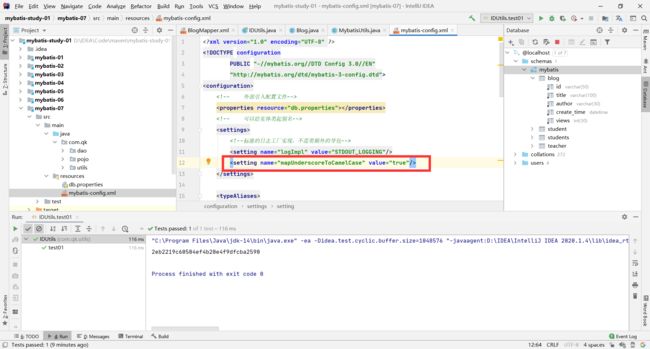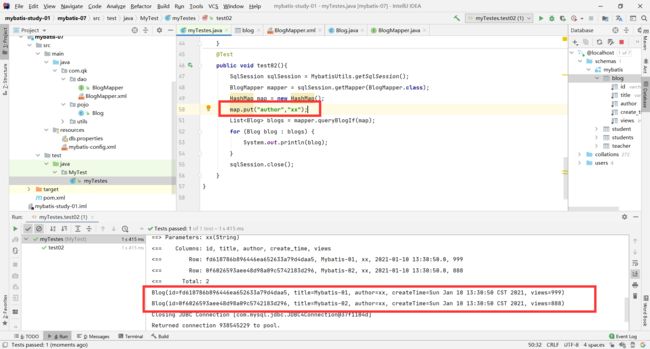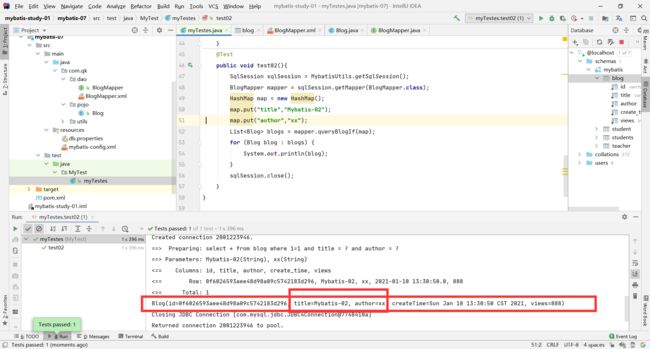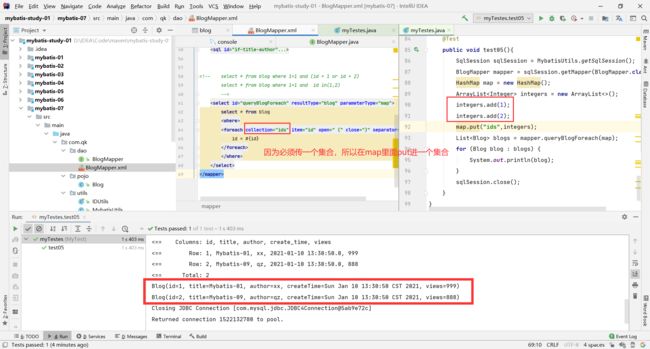Mybatis-动态SQL
什么是动态SQL?
动态SQL就是根据不同的条件生成不同的SQL语句
官网描述:
MyBatis 的强大特性之一便是它的动态 SQL。如果你有使用 JDBC 或其它类似框架的经验,你就能体会到根据不同条件拼接 SQL 语句的痛苦。例如拼接时要确保不能忘记添加必要的空格,还要注意去掉列表最后一个列名的逗号。利用动态 SQL 这一特性可以彻底摆脱这种痛苦。
虽然在以前使用动态 SQL 并非一件易事,但正是 MyBatis 提供了可以被用在任意 SQL 映射语句中的强大的动态 SQL 语言得以改进这种情形。
动态 SQL 元素和 JSTL 或基于类似 XML 的文本处理器相似。在 MyBatis 之前的版本中,有很多元素需要花时间了解。MyBatis 3 大大精简了元素种类,现在只需学习原来一半的元素便可。MyBatis 采用功能强大的基于 OGNL 的表达式来淘汰其它大部分元素。
-------------------------------
- if
- choose (when, otherwise)
- trim (where, set)
- foreach
-------------------------------
<setting name="mapUnderscoreToCamelCase" value="true"/>
1. 搭建环境
2. 插入数据
@Data
public class Blog {
private String id;
private String title;
private String author;
private Date createTime;
private int views;
}
public interface BlogMapper {
//插入数据
int addBlog(Blog blog);
}
<insert id="addBlog" parameterType="blog">
insert into blog
(id,title,author,create_time,views)
value
(#{id},#{title},#{author},#{createTime},#{views})
insert>
@Test
public void testes01(){
SqlSession sqlSession = MybatisUtils.getSqlSession();
BlogMapper mapper = sqlSession.getMapper(BlogMapper.class);
Blog blog = new Blog();
blog.setId(IDUtils.getId());
blog.setTitle("Mybatis-01");
blog.setAuthor("xx");
blog.setCreateTime(new Date());
blog.setViews(999);
mapper.addBlog(blog);
blog.setId(IDUtils.getId());
blog.setTitle("Mybatis-02");
blog.setAuthor("xx");
blog.setCreateTime(new Date());
blog.setViews(888);
mapper.addBlog(blog);
blog.setId(IDUtils.getId());
blog.setTitle("Mybatis-03");
blog.setAuthor("zz");
blog.setCreateTime(new Date());
blog.setViews(777);
mapper.addBlog(blog);
sqlSession.close();
}
3. If
public interface BlogMapper {
List<Blog> queryBlogIf(Map map);
}
- 在没有学where标签前,可以这样拼接,where state = ‘ACTIVE’
<select id="queryBlogIf" parameterType="map" resultType="blog">
select * from blog where state = ‘ACTIVE’
<if test="title != null ">
title = #{title}
if>
<if test="author != null">
and author = #{author}
if>
select>
- 当map为空时
@Test
public void test02(){
SqlSession sqlSession = MybatisUtils.getSqlSession();
BlogMapper mapper = sqlSession.getMapper(BlogMapper.class);
HashMap map = new HashMap();
List<Blog> blogs = mapper.queryBlogIf(map);
for (Blog blog : blogs) {
System.out.println(blog);
}
sqlSession.close();
}
4. where
- where 元素只会在子元素返回任何内容的情况下才插入 “WHERE” 子句。而且,若子句的开头为 “AND” 或 “OR”,where 元素也会将它们去除。
<select id="queryBlogIf" parameterType="map" resultType="blog">
select * from blog
<where>
<if test="title != null ">
title = #{title}
if>
<if test="author != null">
and author = #{author}
if>
where>
select>
5. choose (when, otherwise)
- 有时候,我们不想使用所有的条件,而只是想从多个条件中选择一个使用。针对这种情况,MyBatis 提供了 choose 元素,它有点像 Java 中的 switch 语句。
<select id="queryBlogChoose" resultType="blog" parameterType="map">
select * from blog
<where>
<choose>
<when test="title != null">
title = #{title}
when>
<when test="author != null">
and author = #{author}
when>
<otherwise>
and views = #{views}
otherwise>
choose>
where>
select>
- 可以用where来消除掉拼接SQL语句时and的影响
- 但在choose语句中,始终只会选择其中一条语句,所以可以都不用加and
6. set
- set 元素会动态地在行首插入 SET 关键字,并会删掉额外的逗号(这些逗号是在使用条件语句给列赋值时引入的)。
<update id="updateBlog" parameterType="map">
update blog
<set>
<if test="title != null">
title = #{title},
if>
<if test="author != null">
author = #{author},
if>
set>
where id = #{id}
update>
7. trim
- where 元素等价的自定义 trim 元素为:
<trim prefix="WHERE" prefixOverrides="AND |OR ">
...
trim>
- set 元素等价的自定义 trim 元素
<trim prefix="SET" suffixOverrides=",">
...
trim>
- < trim prefix="" prefixOverrides="" suffix="" suffixOverrides="" >
- 移除所有标签中语句前面 prefixOverrides 属性中指定的内容,并且在前面插入 prefix 属性中指定的内容
- 移除所有标签中语句后面 suffixOverrides 属性中指定的内容,并且在后面插入 suffix 属性中指定的内容
- 这四个属性可以任意搭配
所谓的动态SQL,本质还是SQL语句,只是我们可以在SQL层面,去执行一个逻辑代码
8. SQL片段
- 对于多个sql语句的共有部分,提取出来用,用sql标签提取,include标签复用(代码的复用)
<sql id="if-title-author">
<if test="title != null">
title = #{title}
if>
<if test="author != null">
and author = #{author}
if>
sql>
<select id="queryBlogIf" parameterType="map" resultType="blog">
select * from blog
<where>
<include refid="if-title-author">include>
where>
select>
- 个人总结注意:建议只有相同条件下的语句可以替换:比如都是where或者set包裹的语句,如果只是参数接收语句一样,当心语句之间存在的“and” 和 “,”问题:比如where包裹的语句前面要有“and”,set包裹的后面有“,”
9. Foreach
- foreach 元素的功能非常强大,它允许你指定一个集合,声明可以在元素体内使用的集合项(item)和索引(index)变量
- 也允许你指定开头与结尾的字符串以及集合项迭代之间的分隔符
- 你可以将任何可迭代对象(如 List、Set 等)、Map 对象或者数组对象作为集合参数传递给 foreach
- 当使用可迭代对象或者数组时,index 是当前迭代的序号,item 的值是本次迭代获取到的元素。当使用 Map 对象(或者 Map.Entry 对象的集合)时,index 是键,item 是值。
List<Blog> queryBlogForeach(Map map);
<select id="queryBlogForeach" resultType="blog" parameterType="map">
select * from blog
<where>
<foreach collection="ids" item="id" open=" (" close=")" separator="or">
id = #{id}
foreach>
where>
select>
@Test
public void test05(){
SqlSession sqlSession = MybatisUtils.getSqlSession();
BlogMapper mapper = sqlSession.getMapper(BlogMapper.class);
HashMap map = new HashMap();
ArrayList<Integer> integers = new ArrayList<>();
integers.add(1);
integers.add(2);
map.put("ids",integers);
List<Blog> blogs = mapper.queryBlogForeach(map);
for (Blog blog : blogs) {
System.out.println(blog);
}
sqlSession.close();
}
动态SQL就是在拼接SQL语句,我们只要保证SQL的格式,去排列组合就可以了
建议:
- 现在Mysql中写出完整的SQL,再对应的去修改成为我们的动态SQL实现通用即可







